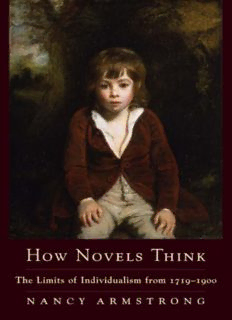
How Novels Think: The Limits of Individualism from 1719-1900 PDF
Preview How Novels Think: The Limits of Individualism from 1719-1900
how novels think Armstrong_FM.indd 1 10/20/05 1:17:26 PM Armstrong_FM.indd 2 10/20/05 1:17:27 PM How Novels Th ink The Limits of British Individualism from 1719–1900 nancy armst ron g columbia university press new york Armstrong_FM.indd 3 10/20/05 1:17:27 PM columbia university press Publishers Since 1893 New York Chichester, West Sussex Copyright © 2005 Columbia University Press All rights reserved Library of Congress Cataloging-in-Publication Data Armstrong, Nancy, 1938– How novels think : the limits of British individualism from 1719–1900 / Nancy Armstrong. p. cm. Includes bibliographical references and index. isbn 0–231–13058–9 (cloth : alk. paper) — isbn 0–231–13059–7 (pbk. : alk. paper) — isbn 0–231–50387–3 (e-book) 1. English fiction—19th century—History and criticism. 2. Individualism in literature. 3. Literature and society—Great Britain—History—19th century. 4. Literature and society—Great Britain—History—18th century. 5. English fiction—18th century. 6. Didactic fiction, English—History and criticism. 7. Ethics in literature. i. Title. pr868.i615a76 2006 823'.809—dc22 2005053782 Columbia University Press books are printed on permanent and durable acid-free paper. Printed in the United States of America c 10 9 8 7 6 5 4 3 2 1 p 10 9 8 7 6 5 4 3 2 1 Armstrong_FM.indd 4 10/20/05 1:17:28 PM In memory of Homer Obed Brown Armstrong_FM.indd 5 10/20/05 1:17:28 PM Armstrong_FM.indd 6 10/20/05 1:17:28 PM Contents Acknowledgments ix Introduction. How Novels Think 1 1. How the Misfit Became a Moral Protagonist 27 2. When Novels Made Nations 53 3. Why a Good Man Is Hard to Find in Victorian Fiction 79 4. The Polygenetic Imagination 105 5. The Necessary Gothic 137 Notes 155 Index 187 Armstrong_FM.indd 7 10/20/05 1:17:28 PM Armstrong_FM.indd 8 10/20/05 1:17:28 PM Acknowledgments My lifelong skepticism about the truth of individualism no doubt in- spired this book, and writing it was far from an individual venture. It could not have happened without the generosity of Rey Chow, who sent me to Jennifer Crewe, the very best of editors. She in turn per- suaded me to make a book-length argument out of a series of talks on the novel I was delivering at a number of universities during the period from 1999 to 2004. These being precisely the years I served as chair of English at Brown University, I relied on conversations with my graduate stu- dents to figure out most of what I wanted to say. That I did come to understand the overarching argument of my research during this period is owing to the remarkable group of new scholars with whom I worked closely, including Carolyn Berman, Frank Christianson, Lois Cucullu, Nick Daly, Amanda Emerson, Jen Fleissner, Jonathan Gold- man, Jared Green, Avak Hasratian, Cole Heinowitz, Ivan Kreilkamp, John Marx, Lisa O’Connell, Caroline Reitz, Jen Ruth, Jason Solinger, Ezra Tawil, Cynthia Tolentino, Annette Van, and Eugenia Zuroski. Without the persistent ingenuity of my research assistant, Sian Silyn Roberts, I would still be lost in the library, looking for the edition of a novel I cited or tracking down the exact title of an article I read a year or two ago. I am equally indebted to the junior faculty hired and in three cases tenured during my years as chair: Timothy Bewes, Stuart Burrows, Jean ix Armstrong_FM.indd 9 10/20/05 1:17:28 PM
Description: